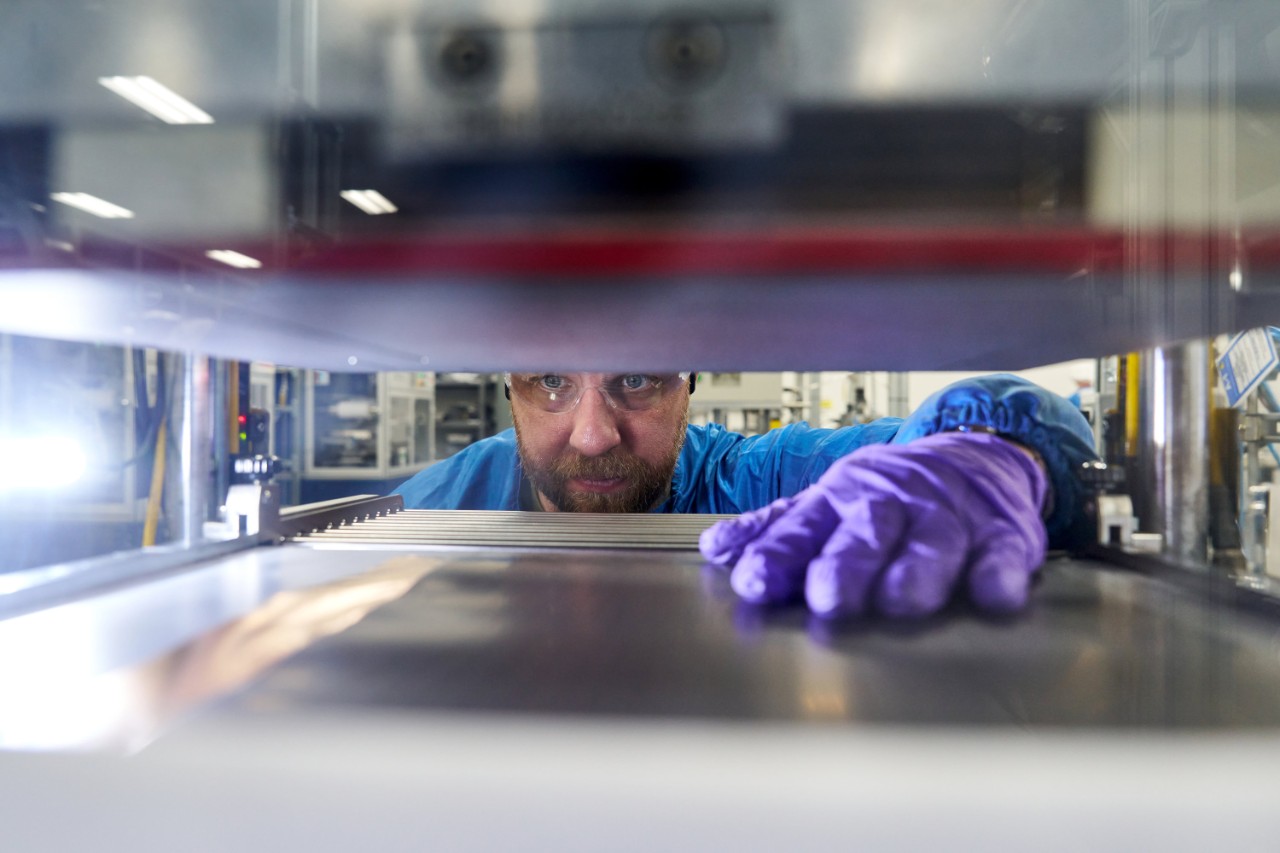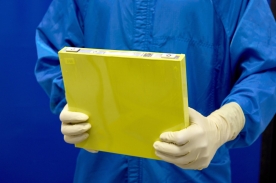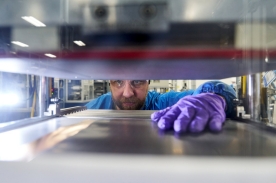GM and LG Energy Solution to pioneer LMR battery cell technology
2025-05-13
General Motors and LG Energy Solution will commercialize lithium manganese-rich (LMR) prismatic battery cells for future GM electric trucks and full-size SUVs, in a new battery technology breakthrough. This builds on a partnership between the two companies to develop prismatic battery cell technology and related chemistries, and on GM’s long legacy of American ingenuity that’s produced innovations like the small-block V8 engine, OnStar connected vehicle services and hands-free Super Cruise.
GM aims to become the first automaker to deploy LMR batteries in EVs. Ultium Cells, a GM and LG Energy Solution joint venture, plans to start commercial production of LMR prismatic cells in the United States by 2028, with pre-production expected to begin at an LG Energy Solution facility by late 2027. The final production-design of these LMR battery cells will be validated at GM’s Battery Cell Development Center in Warren, MI, which is expected to open earlier that year, as well as LG Energy Solution’s facility.
Battery cathodes require materials like cobalt, nickel and manganese, with cobalt being the most expensive. LMR battery cells use a higher proportion of more affordable manganese, while also delivering greater capacity and energy density.
Battery engineers at GM and LG Energy Solution have developed a new LMR prismatic battery cell that unlocks 33% higher energy density compared to the best-performing lithium iron phosphate (LFP) based cells – at a comparable cost.
GM's electric truck platform has segment-leading range using high-nickel chemistry today. By integrating LMR battery technology and the manufacturing and space efficiency benefits of prismatic cells, GM aims to offer more than 400 miles of range in an electric truck while achieving significant battery pack cost savings compared to today’s high-nickel pack.
“We’re pioneering manganese-rich battery technology to unlock premium range and performance at an affordable cost, especially in electric trucks,” said Kurt Kelty, VP of battery, propulsion, and sustainability at GM. “As we look to engineer the ideal battery for each vehicle in our diverse EV portfolio, LMR will complement our high-nickel and iron-phosphate solutions to expand customer choice in the truck and full-size SUV markets, advance American battery innovation, and create jobs well into the future.”
“We’re excited to introduce the first-ever LMR prismatic cells for EVs, the culmination of our decades-long research and investment in the technology,” said Wonjoon Suh, executive VP and head of the Advanced Automotive Battery division at LG Energy Solution. “GM’s future trucks powered by this new chemistry are a strong example of our shared commitment to offering diverse EV options to consumers.”
GM began researching manganese-rich lithium-ion battery cells in 2015, accelerating this technology development by prototyping LMR cells at its Wallace Battery Cell Innovation Center in Warren. In collaboration with partners, GM engineers advanced cathode materials, electrolytes, additives, form factors, and cell assembly processes to overcome LMR’s legacy challenges in performance and durability.
LG Energy Solution holds the largest LMR technology IP portfolio globally, having secured over 200 patents1 in this technology field. Its expertise reflects extensive research, with its first patent on LMR chemistry dating back to 2010.
LMR battery technology integrates into GM’s battery supply chain and cell manufacturing processes, reinforcing strategic investments in domestic battery production and the responsible sourcing of critical materials like lithium, graphite, and manganese from North America.
###
General Motors (NYSE:GM) is driving the future of transportation, leveraging advanced technology to build safer, smarter, and lower emission cars, trucks, and SUVs. GM's Buick, Cadillac, Chevrolet, and GMC brands offer a broad portfolio of innovative gasoline-powered vehicles and the industry's widest range of EVs, as we move to an all-electric future. Learn more at GM.com.
LG Energy Solution (KRX: 373220), a split-off from LG Chem, is a leading global manufacturer of lithium-ion batteries for electric vehicles, mobility, IT, and energy storage systems. With 30 years of experience in revolutionary battery technology and extensive research and development (R&D), the company is the top battery-related patent holder in the world with over 69,600 patents. Its robust global network, which spans North America, Europe, and Asia, includes battery manufacturing facilities established through joint ventures with major automakers. Committed to building sustainable battery ecosystem, LG Energy Solution aims to achieve carbon neutrality across its value chain by 2050, while embodying the value of shared growth and promoting diverse and inclusive corporate culture. To learn more about LG Energy Solution’s ideas and innovations, visit https://news.lgensol.com/.
Cautionary Note on Forward-Looking Statements: This press release and related comments by management may include "forward-looking statements" within the meaning of the U.S. federal securities laws. Forward-looking statements are any statements other than statements of historical fact and represent our current judgment about possible future events. In making these statements, we rely upon assumptions and analysis based on our experience and perception of historical trends, current conditions, and expected future developments, as well as other factors we consider appropriate under the circumstances. We believe these judgments are reasonable, but these statements are not guarantees of any future events or financial results, and our actual results may differ materially due to a variety of factors, many of which are described in our most recent Annual Report on Form 10-K and our other filings with the U.S. Securities and Exchange Commission. We caution readers not to place undue reliance on forward-looking statements. Forward-looking statements speak only as of the date they are made, and we undertake no obligation to update publicly or otherwise revise any forward-looking statements, whether as a result of new information, future events, or other factors that affect the subject of these statements, except where we are expressly required to do so by law.
1Number of patent applications in IP5 (Korea, U.S., Europe, Japan, China) as of Dec. 31, 2024
An employee holds a full-size prototype LMR battery cell at the General Motors Wallace Battery Cell Innovation Center in Warren, Michigan. Photo by Steve Fecht for General Motors.
General Motors and LG Energy Solution will commercialize lithium manganese-rich (LMR) prismatic battery cells for future GM electric trucks and full-size SUVs, in a new battery technology breakthrough. This builds on a partnership between the two companies to develop prismatic battery cell technology and related chemistries, and on GM’s long legacy of American ingenuity that’s produced innovations like the small-block V8 engine, OnStar connected vehicle services and hands-free Super Cruise.
GM aims to become the first automaker to deploy LMR batteries in EVs. Ultium Cells, a GM and LG Energy Solution joint venture, plans to start commercial production of LMR prismatic cells in the United States by 2028, with pre-production expected to begin at an LG Energy Solution facility by late 2027. The final production-design of these LMR battery cells will be validated at GM’s Battery Cell Development Center in Warren, MI, which is expected to open earlier that year, as well as LG Energy Solution’s facility.
Battery cathodes require materials like cobalt, nickel and manganese, with cobalt being the most expensive. LMR battery cells use a higher proportion of more affordable manganese, while also delivering greater capacity and energy density.
Battery engineers at GM and LG Energy Solution have developed a new LMR prismatic battery cell that unlocks 33% higher energy density compared to the best-performing lithium iron phosphate (LFP) based cells – at a comparable cost.
General Motors battery technician Steven Petty Jr. focuses on aligning electrodes on an anode sample for a prototype LMR battery cell in the making. (Photo by Steve Fecht for General Motors)
GM's electric truck platform has segment-leading range using high-nickel chemistry today. By integrating LMR battery technology and the manufacturing and space efficiency benefits of prismatic cells, GM aims to offer more than 400 miles of range in an electric truck while achieving significant battery pack cost savings compared to today’s high-nickel pack.
“We’re pioneering manganese-rich battery technology to unlock premium range and performance at an affordable cost, especially in electric trucks,” said Kurt Kelty, VP of battery, propulsion, and sustainability at GM. “As we look to engineer the ideal battery for each vehicle in our diverse EV portfolio, LMR will complement our high-nickel and iron-phosphate solutions to expand customer choice in the truck and full-size SUV markets, advance American battery innovation, and create jobs well into the future.”
“We’re excited to introduce the first-ever LMR prismatic cells for EVs, the culmination of our decades-long research and investment in the technology,” said Wonjoon Suh, executive VP and head of the Advanced Automotive Battery division at LG Energy Solution. “GM’s future trucks powered by this new chemistry are a strong example of our shared commitment to offering diverse EV options to consumers.”
GM began researching manganese-rich lithium-ion battery cells in 2015, accelerating this technology development by prototyping LMR cells at its Wallace Battery Cell Innovation Center in Warren. In collaboration with partners, GM engineers advanced cathode materials, electrolytes, additives, form factors, and cell assembly processes to overcome LMR’s legacy challenges in performance and durability.
LG Energy Solution holds the largest LMR technology IP portfolio globally, having secured over 200 patents1 in this technology field. Its expertise reflects extensive research, with its first patent on LMR chemistry dating back to 2010.
LMR battery technology integrates into GM’s battery supply chain and cell manufacturing processes, reinforcing strategic investments in domestic battery production and the responsible sourcing of critical materials like lithium, graphite, and manganese from North America.
###
General Motors (NYSE:GM) is driving the future of transportation, leveraging advanced technology to build safer, smarter, and lower emission cars, trucks, and SUVs. GM's Buick, Cadillac, Chevrolet, and GMC brands offer a broad portfolio of innovative gasoline-powered vehicles and the industry's widest range of EVs, as we move to an all-electric future. Learn more at GM.com.
LG Energy Solution (KRX: 373220), a split-off from LG Chem, is a leading global manufacturer of lithium-ion batteries for electric vehicles, mobility, IT, and energy storage systems. With 30 years of experience in revolutionary battery technology and extensive research and development (R&D), the company is the top battery-related patent holder in the world with over 69,600 patents. Its robust global network, which spans North America, Europe, and Asia, includes battery manufacturing facilities established through joint ventures with major automakers. Committed to building sustainable battery ecosystem, LG Energy Solution aims to achieve carbon neutrality across its value chain by 2050, while embodying the value of shared growth and promoting diverse and inclusive corporate culture. To learn more about LG Energy Solution’s ideas and innovations, visit https://news.lgensol.com/.
Cautionary Note on Forward-Looking Statements: This press release and related comments by management may include "forward-looking statements" within the meaning of the U.S. federal securities laws. Forward-looking statements are any statements other than statements of historical fact and represent our current judgment about possible future events. In making these statements, we rely upon assumptions and analysis based on our experience and perception of historical trends, current conditions, and expected future developments, as well as other factors we consider appropriate under the circumstances. We believe these judgments are reasonable, but these statements are not guarantees of any future events or financial results, and our actual results may differ materially due to a variety of factors, many of which are described in our most recent Annual Report on Form 10-K and our other filings with the U.S. Securities and Exchange Commission. We caution readers not to place undue reliance on forward-looking statements. Forward-looking statements speak only as of the date they are made, and we undertake no obligation to update publicly or otherwise revise any forward-looking statements, whether as a result of new information, future events, or other factors that affect the subject of these statements, except where we are expressly required to do so by law.
1Number of patent applications in IP5 (Korea, U.S., Europe, Japan, China) as of Dec. 31, 2024



